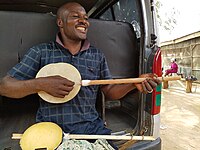Garaya (lute)

The garaya or komo is an oval-bodied, two-string spike lute from Niger and Northern Nigeria.[2]
Details
[edit]Two different versions of the garaya exist in Nigeria.[1] The Fulani people and Hausa people both have their own version.[1]
Hausa garaya
[edit]A garaya is around 50 centimeters long, plucked with a plectrum made from stiffened cowhide or hippopotamus hide.[2][3] It is used by the Hausa people to play traditional music.[2] The instrument has a wooden soundbox in the shape of an oval, covered with goatskin or duiker-skin and a neck that goes through both sides of the bowl. From the butt, the strings run across the bowl, and the loose ends are tied to tuning strings (which are wrapped around the neck as anchor points). The lute may have a metal jingle attached to the handle.[2]
A larger version of the instrument is called the babbar garaya or komo.[3] Babbar means large.[3] The instrument has a gourd body or soundbox and is about 75 centimeters long.[3]
The komo (also 2 strings) is equivalent to the garaya.[3] It has a soundbox made from a gourd (instead of wood) and is about 75 centimeters long.[3]
The instruments have traditionally been played to make "praise" songs for hunters, accompanied by gourd rattles.[2][3] The instruments are used for entertainment, accompanying song and dance.[3] They have also been used in a religious context, part of the "bori spirit possession cult."[2][3]
See also
[edit]- Krar, a five or six-stranded bowl-shaped lyre used in Ethiopia and Eritrea
References
[edit]- ^ a b c Pestcoe, Shlomo; Adams, Greg C. "3 List of West African Plucked Spike Lutes". In Robert B. Winnans (ed.). Banjo Roots and Branches. pp. 47–48.
Semi-Spike Lutes...garaya [plural garayu] (Hausa: Nigeria) (two strings)...garaya [garayaaru, garayaaji] (Fulani [Fulbe]:Cameroon) (two strings; gourd body)
- ^ a b c d e f Gourlay, K. A. (1984). "Garaya". In Sadie Stanley (ed.). The New Grove Dictionary of Musical Instruments. Vol. 2. London: MacMillan Press. p. 25.
- ^ a b c d e f g h i Gourlay, K. A. (1984). "Komo". In Sadie Stanley (ed.). The New Grove Dictionary of Musical Instruments. Vol. 2. London: MacMillan Press. p. 454.
Text is available under the CC BY-SA 4.0 license; additional terms may apply.
Images, videos and audio are available under their respective licenses.
